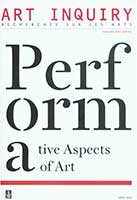Performative spaces in contemporary Polish art
Performative spaces in contemporary Polish art
Author(s): Paulina SztabińskaSubject(s): Fine Arts / Performing Arts
Published by: Łódzkie Towarzystwo Naukowe
Keywords: performativity; space; Erika Fischer-Lichte; installation; environment; public art
Summary/Abstract: Positing the division of space into geometric and performative, and pointing to the three strategies of its intensification proposed by Erika Fischer-Lichte in reference to the theater, the author of the article attempts to find their counterparts in visual arts. The article focuses on some Polish examples of public art, environment and installation. The first strategy of intensification distinguished by Fischer-Lichte concerned the use of empty or nearly empty stage space, whose arrangement could change, allowing for different patterns of movement of the actors or the spectators. The article discusses whether it is possible to determine the relationship of a work of art with an empty gallery space through its active management. The objects used by artists are meant to intensify the sense of lack, emptiness and absence, to stimulate imagination and sensitivity, or to refer to spiritual values. Effects of this type are discussed on the example of the works of Jan Berdyszak and Mirosław Bałka. According to the second strategy of the performative approach to space in theater, happening and performance art, the chosen place of action allows or rejects certain modes of behavior. Thus, there is no freedom of assigning meaning. This kind of situation occurs in the case of Wojciech Fangor’s environment and of Składaki by Maciej Szańkowski. The artists create a new space with their works, at the same time determining, through its characteristics, the situation of their reception, a specific energy that varies depending on the number of recipients, their age and other factors. The third strategy of the intensification of performativity defined by Fisher-Lichte is the use of pre-existing and reclaimed spaces, whose features are modified in the course of the action. In the case of theater, these are performances arranged in town squares, in industrial interiors, in rural areas, on beaches, etc. In the visual arts, an analogous procedure was used in Mikołaj Smoczyński’s installation Labirynt, realized at the Ujazdowski Castle in Warsaw and even more explicitly in Joanna Rajkowska’s Dotleniacz. The works by Polish artists described here do not posit the concept of a work as an artifact meant for timeless and universal contemplation. They take into account what is current, unstable, fleeting, dependent on the will and decision of not only the artist but also the spectator. They demonstrate the ability to assign a performative sense to space without having to refer to the actors’ actions, as in the case of theater performances.
Journal: Art Inquiry
- Issue Year: 2012
- Issue No: 14
- Page Range: 165-183
- Page Count: 19
- Language: English

